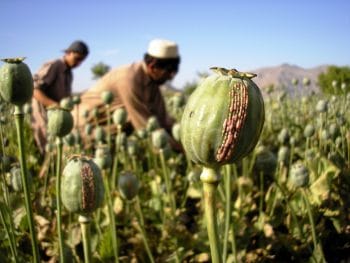
Heroin Production and the Conflict in Afghanistan
The Opioid epidemic in America is responsible for killing hundreds of mothers, fathers, sisters and brothers each day. Americans spend millions of dollars in the U.S. treating substance use disorders as a result of Opioid dependence. The U.S. has spent $1.5 million each day fighting a war on drugs (Opium, in particular) in Afghanistan. In 15 years, the country has increased Opium production more than fourfold; 1,266 square miles are used for the cultivation of the drug. In attempts to minimize the devastation of Opium and Heroin production, the American military carried out over 200 strikes as a part of operation “Iron Tempest” on what it considered high-value Taliban drug manufacturing targets.
The Taliban reportedly earns over $200 million a year via Opium drug trade manufacturing.
The increase in Afghanistan land area for poppy cultivation and the production of Opium remain deeply connected to the war in Afghanistan. Money from Heroin production financially supports the Taliban as well as the Islamic State and Al Qaeda. It is also deeply rooted in the country’s corrupt public systems. Because of this, Opium farms heavily populate the fields of Afghanistan. Farmers are aware of the dangers of growing drugs in the country, yet some continue to work the fields.
In 2017, the U.N. Office on Drugs and Crime reported the effects of Afghanistan’s poppy cultivation. Within a year, cultivation had increased 120,000 hectares, or about 463 square miles – and numbers keep climbing. Today, much of the Afghani Opium supply is converted into Morphine or Heroin, making it easier to ship and conceal. Dubbed the biggest Opium producer in the world, 90% of the world’s Heroin is made from Opium grown in Afghanistan.
Striking Down Laboratories and Raising Questions
American military forces cooperated in the Iron Tempest campaign, bombing Opium labs and “hitting the Taliban where it hurts, which is their finances,” according to commander of forces, General John Nicholson. Unfortunately, this led to the deaths of 9 Afghani civilians. The multi-million-dollar campaign has created some skeptics, prompting them to analyze its purpose despite intentions to control the distribution of Heroin worldwide.
Dr. David Mansfield has extensively studied the creation and effect of the Afghan Opium industry. Mansfield watched 23 videos released by the military of footage of the strikes and questioned the results, claiming “there was no significant Heroin production at the vast majority” of the labs targeted. Mansfield and the Alcis team further examined the videos and used geospatial analysis to uncover the reality of the air strikes. They found the sites were once used as heroin labs, but not recently.
What is the loss to a drug trafficking organisation when you essentially hit a building, a mud compound?
Afghani Opium study author, 2019
Mansfield remained puzzled in understanding the purpose of the attacks on civilians. He estimates the value of the bombed “mud huts” or military targets were between “$10,000 to $20,000 per compound.”
In the meantime, the country continues to subsist from the large amounts of money made from Opium production, creating “600,000 full-time jobs” for its citizens.